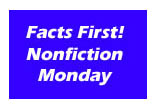
Polar Bears and Penguins: A Compare and Contrast Book
by Katharine Hall (Author)
Booktalk: Polar bears and penguins may like cold weather but they live at opposite ends of the Earth. What do these animals have in common and how are they different?
Snippet: Polar bears live in the Arctic, in the Northern Hemisphere…
TURN THE PAGE
…but penguins live in the Southern Hemisphere.

It’s STEM Friday! (STEM is Science, Technology, Engineering, and Mathematics)
Copyright © 2014 Anastasia Suen All Rights Reserved.














